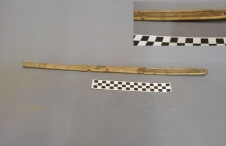Ice Age Nevada and Lake Lahontan
Between about 25,000 and 11,000 years ago, Nevada's late ice age climate was much cooler and wetter than today. While glaciers only occupied mountain ranges, much of the vegetation was similar to that of today, although it was found in different settings. This interval represents the end of the Wisconsin Stage of North America's Pleistocene geologic period, and it is well represented by the Nevada's paleontology and geology.
Instead of a literal ice age, in which land is covered by continental glaciers, the Great Basin's Ice Age was marked by increased precipitation and reduced evaporation, known as a "pluvial" climate. This increased stream flow and encouraged lake formation. The Great Basin received its name because rivers and streams that originate in the mountains drain into the basin and end in lakes or sinks within valley bottoms throughout the region. During the Ice Age, the Great Basin region supported two major late Pleistocene pluvial lakes: Lake Lahontan and Lake Bonneville. Lake Bonneville lay almost exclusively in western Utah, and only a small area in eastern Nevada, while Lake Lahontan was mainly restricted to western Nevada.
Lake Lahontan reached a maximum depth of over 500 feet and covered over 8,610 square miles, with vast stretches of open water separated by mountain ranges. Open water encouraged wave formation and strong currents within the lake. Surrounding mountain ranges were carved by waves that formed caves and multiple terraces. Currents moved stones and boulders, forming massive spits and dikes. Four major river systems—The Walker, Carson, Truckee, and Humboldt, as well as numerous smaller drainages—fed Lake Lahontan.
The geological evidence for Lake Lahontan is best represented by its last major rise and fall. After a multi-millennial interval of warm, dry conditions around 25,000 years ago, each major river system began to fill its terminal lake basin until it overflowed into neighboring basins. One by one, drainage basins filled with water that began spilling over a pass or through a cut. Eventually, these individual lakes coalesced into a single water body, Lake Lahontan.
As water breached a lake basin's threshold, some stability was reached in that lake's level as the receiving basin filled. Lake terraces represent some of these major events. The nature of a region's climate is dynamic, and during the lake's 75,000-year history, there were a series of major lake stands or lake levels known collectively as Lake Lahontan. Similarly, prior to about 75,000 years ago, there were other unnamed lakes occupying the same area.
The vegetation of the Great Basin was comprised of today's species, but plant communities occurred up to 1,000 feet lower in elevation than they do today. Las Vegas Valley's yucca, Joshua tree, creosote, and mesquite vegetation were preceded by an Ice Age juniper woodland interspersed with sagebrush. Pinyon pine forests were absent in northern and central parts of the state, and the compositions of some plant communities were unique to that time. For example, shadscale, a lower elevation desert shrub, grew within western juniper groves along the shore of Lake Lahontan within the Winnemucca Lake basin. Today, 2,000 or more feet and ten miles separate the two.
Perhaps the most striking differences between this period and today are the Ice Age animals that roamed the landscape. Mammoths, giant ground sloths, camels, shrub oxen, horses, cheetahs, and other extinct mammals are known to have inhabited Nevada during this time. Sandstone deposits quarried at the Nevada State Prison in the nineteenth century yielded sets of animal tracks from Pleistocene mammoths or mastodons, giant ground sloths, camels, bison, and horses. Fossil bones of mammoths, horses, and camels were uncovered, along with an obsidian flake and a possible bone tool. At Tule Springs in the 1930s, apparent fire hearths were found within present day Floyd Lamb State Park, north of Las Vegas. This tantalizing evidence led to a major archaeological project that did yield evidence of the presence of people some 10,000 years ago, but the association of them with extinct fauna was not supported.
A most curious paleontological discovery occurred at Gypsum Cave approximately thirty miles northeast of downtown Las Vegas. Prior to about 11,000 years ago, Gypsum Cave had served as an Ice Age latrine for giant ground sloths for thousands of years. The cave was packed with layers of ground sloth droppings. The toilet behavior of this nine-foot-long herbivore can be inferred from modern tree sloths who defecate only once or twice a week at the base of a tree, forming a sizeable dung pile. This may serve as a territorial marker. Gypsum Cave is also of interest because of the purported association between humans and the ground sloths, something that has also failed to be substantiated in recent excavations.
The end of the Pleistocene era occurred with a warming and drying trend. Lake Lahontan separated into smaller and smaller basins, which were isolated by intervening mountain ranges. The last lake remnants can be seen in Walker and Pyramid lakes. Throughout its former basin, however, miles of ancient lake terraces tell of its former extent, and deep-water silts and clays lie beneath dusty playas. Curious tufa formations and fossil mollusk shells provide further evidence of the once mighty lake. Perhaps the best known living relic of Nevada's ice age is Pyramid Lake's unique cui-ui fish.
Article Locations
Related Articles
Further Reading
None at this time.

